Preliminary data on India’s balance of payments (BoP) for the third
quarter (Q3) of the financial year 2006-07 i.e., October-December 2006,
are now available. These preliminary data, combined with the partially revised
data for the first two quarters (i.e., April-June 2006 and July-September
2006) provide an assessment of the BoP for the period April-December 2006. Full
details of BoP data are set out in the standard format of presentation in Statement
1, Statement
2. October-December 2006
The major items of the BoP for Q3 of 2006-07 are set out in Table
1 and details in Statement 1.
Table
1: Major Items of India's Balance of Payments- October-December 2006 |
(US $ million) |
Items | April-
June | July-
September | October-
December | October-
December |
| 2006PR | 2006PR | 2006P | 2005PR |
1 | 2 | 3 | 4 | 5 |
Exports | 29,674 | 32,798 | 28,862 | 25,318 |
Imports | 46,898 | 48,855 | 47,883 | 38,298 |
Trade Balance | -17,224 | -16,057 | -19,021 | -12,980 |
Invisibles, net | 13,127 | 11,375 | 15,979 | 8,198 |
Current Account Balance | -4,097 | -4,682 | -3,042 | -4,782 |
Capital Account* | 10,475 | 6,950 | 10,547 | 110 |
Change in Reserves
(- Indicates increase) # | -6,378 | -2,268 | -7,505 | 4,672 |
*: Including errors and omissions.
#: On BoP basis excluding valuation. |
P: Preliminary PR: Partially Revised. |
Merchandise Trade - On BoP basis, India’s
Merchandise exports posted a moderate growth of 14 per cent in Q3 of 2006-07 as
compared with 21.2 per cent in Q3 of the previous year.
- Import payments,
on BoP basis, recorded 25.0 per cent growth in Q3 of 2006-07 as against an increase
of 17.3 per cent in Q3 of 2005-06.
- According to the commodity-wise break
up released by Directorate General of Commercial Intelligence and Statistics (DGCI&S),
the deceleration in exports growth (up to November 2006) was mainly due to slowdown
in exports of manufactured goods.
- According to the data released by DGCI&S,
while oil imports recorded an increase of 35.4 per cent in Q3 of 2006-07 (53.9
per cent in Q3 of 2005-06), non-oil imports witnessed a growth of 24.0 per cent
(11.9 per cent in Q3 of 2005-06).
- Oil imports reflected the impact of
high oil price of the Indian basket of international crude (a mix of Dubai and
Brent varieties), which rose to US $ 58.3 per barrel in Q3 of 2006-07 from US
$ 54.5 per barrel in the corresponding quarter of the previous year.
- Non-oil
imports showed momentum due to seasonal upturn in the gold demand with stable
prices, and pick up in metalliferrous ores and metal scraps, iron and steel, pearls,
precious and semi-precious stones, besides the steady growth in capital goods.
Trade Deficit - Strong oil import demand
along with pick-up of non-oil imports, led to a steady expansion in trade deficit,
on BoP basis, to US $ 19.0 billion in Q3 of 2006-07 (US $ 13.0 billion in Q3 of
2005-06)
Invisibles - Net invisible receipts
nearly doubled in Q3 of 2006-07 on account of sharp rise in invisible receipts
(33.4 per cent), while payments remained at almost the same level as the corresponding
period of the previous year, which included India Millennium Deposits (IMDs) interest
payments.
- Steady expansion in invisibles surplus reflected mainly
the rise in software, professional and business services, and remittances from
overseas Indians.
Current Account Deficit
- Despite widening of the trade deficit to US $ 19.0 billion in Q3 of 2006-07
(US $ 13.0 billion in Q3 of 2005-06), current account deficit narrowed to US $
3.0 billion in Q3 of 2006-07 (US $ 4.8 billion in Q3 of 2005-06) due to large
invisibles receipts.
Capital Account and Reserves
- The net capital inflows in Q3 of 2006-07 were placed substantially higher
at US $ 10.7 billion than that of US $ 0.4 billion in Q3 of 2005-06. It may be
mentioned that in Q3 of 2005-06, net capital flows were affected by outflows due
to repayments of IMDs (US $ 5.5 billion).
- Under capital account,
while the direct investment showed strong bi-directional movement, reflecting
higher inward as well as outward investments, portfolio investment turned buoyant
on the back of rising stock prices.
- While the direct investment inflows
to India surged in the third quarter (US $ 8.7 billion), outward direct investment
from India (US $ 6.4 billion) also showed strong growth due to some large overseas
acquisitions.
- The major contributors to net capital inflows
were external commercial borrowings, NRI deposits and other capital.
- Other capital has been an important component of capital account in Q3 of
2006-07 (US $3.2 billion). The large increase in other capital is due to difference
in the banking channel and the DGCI&S data (US $4.1 billion).
- On BoP basis, accretion to foreign exchange reserves (excluding valuation)
at US $ 7.5 billion in Q3 of 2006-07 was higher than US $ 4.7 billion in Q3 of
2005-06.
April-December 2006
Taking into account the partially revised data for the Q1 and Q2 of 2006-07 and
the preliminary data compiled for Q3 of 2006-07, the BoP position for the period
April-December of the financial year 2006-07 has been worked out. While the detailed
data are set out in Statement 2 in standard format of presentation, the major
items are set out in Table 2.
Table
2: India's Balance of Payments: April-December 2006 |
(US $ million) |
| April-December
2006 | April-December
2005 | 1 | 2 | 3 |
Exports | 91,334 | 74,573 |
Imports | 143,636 | 114,662 |
Trade Balance | -52,302 | -40,089 |
Invisibles, net | 40,481 | 28,147 |
Current Account Balance | -11,821 | -11,942 |
Capital Account* | 27,972 | 13,773 |
Change in Reserves#
(- Indicates increase) | -16,151 | -1,831 |
*: Including errors and omissions.
#: On BoP basis excluding valuation. | Merchandise
Trade - On BoP basis, merchandise exports recorded an increase
of 22.5 per cent during April-December 2006 (29.5 per cent in the corresponding
period of the previous year).
- Merchandise import payments,
on BoP basis, showed 25.3 per cent growth in April-December 2006 as compared with
36.2 per cent in the corresponding period of previous year.
- According
to commodity-wise data released by DGCI&S (up to November 2006), deceleration
in exports growth occurred on account of slowdown in exports of manufactured goods
viz., chemical and related products, textile and textile products, leather
and manufactures, and decline in exports of handicrafts and gems and jewellery.
- Oil imports, as per DGCI&S data, increased by 39.2
per cent in April-December 2006 (46.9 per cent in April-December 2005), while
non-oil imports recorded a moderate growth of 18.6 per cent ( 34.3 per cent in
April-December 2005).
- The rise in crude oil imports reflected (i) elevated
international oil prices despite some moderation in the third quarter of 2006-07,
and (ii) the strong volume growth. While the average crude oil price recorded
a year-on-year increase of 19 per cent during April-December 2006, volume growth
was about 16 per cent.
- The average price of the Indian basket of international
crude (a mix of Dubai and Brent varieties) rose to US $ 64.3 per barrel in April-December
2006 from US $ 54 per barrel in the corresponding period of the previous year
(Chart 1).
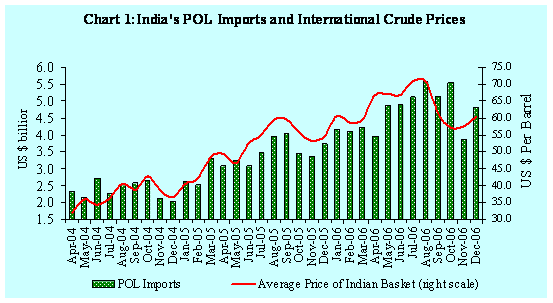
Trade Deficit
- With the growth in imports, mainly
on account of oil imports, outstripping the pace of export growth, merchandise
trade deficit, on a BoP basis, sharply increased to US $ 52.3 billion from US
$ 40.1 billion in April-December 2005 (Chart 2).
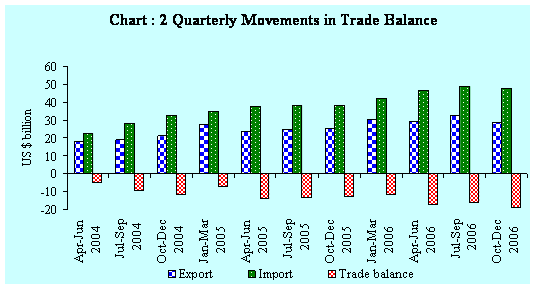
Invisibles - Invisible receipts rose by
29.9 per cent during April-December 2006 mainly due to significant growth in software
exports, other professional and business services, travel and transportation,
besides steady inflow of remittances from overseas Indians
(Table
3).
Table
3: Invisible Gross Receipts and Payments: April-December 2006 |
(US $ million) |
Items | Invisible
Receipts | Invisible
Payments | | April-Dec
2006 | April-Dec 2005 | April-
Dec 2006 | April-Dec 2005 |
1 | 2 | 3 | 4 | 5 |
Travel | 6,425 | 5,344 | 5,444 | 4,556 |
Transportation | 5,848 | 4,510 | 6,298 | 5,597 |
Insurance | 844 | 778 | 479 | 678 |
Govt. not included elsewhere | 211 | 223 | 308 | 330 |
Transfers | 19,964 | 17,562 | 1021 | 625 |
Income | 5,970 | 3,890 | 9,496 | 9,096 |
Investment Income | 5,728 | 3,789 | 8,828 | 8,530 |
Compensation of Employees | 242 | 101 | 668 | 566 |
Miscellaneous | 43,371 | 31,287 | 19,106 | 14,565 |
Of Which: Software | 21,762 | 16,575 | 1619 | 978 |
Total | 82,633 | 63,594 | 42,152 | 35,447 |
- Private transfer receipts, comprising primarily remittances from
Indians working overseas, remained steady at US $ 19.6 billion in April-December
2006 as compared with US $ 17.2 billion in April-December 2005 (Chart 3).
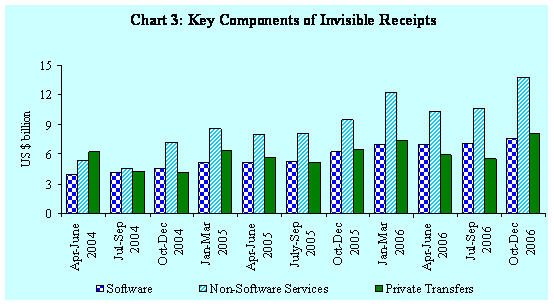
- Invisible payments also grew (18.9 per cent) during April-December 2006 on
account of surge in outbound tourist traffic, business services such as business
and management consultancy, engineering, technical and dividend and profit payouts.
- The miscellaneous receipts, net of software, were recorded at US $ 21.6
billion in April-December 2006 (US $ 14.7 billion in April-December 2005). The
break-up is presented in Table 4.
Table
4: Break-up of Non-Software Miscellaneous Receipts and Payments |
( US $ million) |
Items | Receipts | Payments |
| Apr-Dec
| Apr-Dec | Apr-Dec
| Apr-Dec |
2006 | 2005 | 2006 | 2005 |
1 | 2 | 3 | 4 | 5 |
Communication Services | 1451 | 1442 | 550 | 459 |
Construction | 279 | 792 | 575 | 522 |
Financial | 1,598 | 1231 | 966 | 958 |
News Agency | 316 | 257 | 119 | 206 |
Royalties, Copyrights & License Fees | 84 | 100 | 703 | 484 |
Business Services | 16,496 | 8,333 | 12,501 | 6,811 |
Personal, Cultural, Recreational | 176 | 86 | 93 | 74 |
Others | 1,209 | 2,471 | 1,980 | 4,073 |
Total | 21,609 | 14,712 | 17,487 | 13,587 |
- Business services receipts and payments both were mainly driven
by trade related services, business and management consultancy services, architectural
and engineering services and other technical services, and office maintenance
services. These reflect the underlying momentum in trade of professional and technology
related services.
Current Account Deficit
- Current account deficit at US $ 11.8 billion in April-December 2006 remained
broadly at the same level of the corresponding period of the previous year mainly
on account of higher net invisibles receipts (Chart 4).
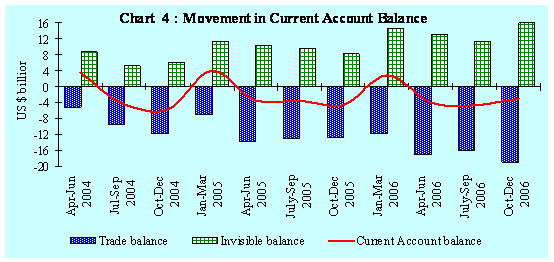
Capital
Account - Net capital flows surged to US $ 27.3 billion from
US $ 13.4 billion in April-December 2005.
- The capital flows, were dominated
by strong bi-directional movement in foreign direct investment, and buoyant inflows
through external commercial borrowings (ECBs), NRI deposits and portfolio flows
(Table 5).
Table
5: Net Capital Flows during April-December 2006 | (US
$ million) | Items | April-Dec
2006 | April-Dec 2005 |
1 | 2 | 3 |
Foreign Direct Investment | 5,822 | 3,347 |
Portfolio Investment | 5,170 | 8,161 |
External Assistance | 934 | 1090 |
External Commercial Borrowings | 9,104 | -1,211 |
NRI Deposits | 3,201 | 1114 |
Other Banking Capital | -2,095 | 686 |
Short-term Credits | 1,329 | 1731 |
Others | 3,878 | -1,484 |
Total | 27,343 | 13,434 |
- Net FDI into India accelerated on the strength of sustained
domestic activity and positive investment climate with inflows channeling into
manufacturing, business and computer services. FDI was channelled mainly into
financial services, manufacturing, banking services, information technology services
and construction. Mauritius, the US and Singapore remain the dominant sources
of FDI to India.
- Outward FDI of India also showed robust
increase due to appetite of Indian companies for global expansion reflected in
some large overseas acquisitions.
- As regards portfolio equity flows, foreign
institutional investors (FIIs) made large purchases in the Indian stock market
during August-November 2006, more than offsetting the outflows witnessed during
May-July 2006. During December 2006, however, FIIs registered outflows against
the backdrop of volatility in Asian equity markets subsequent to the tightening
of capital controls by Thailand. On the whole, net FII inflows during April-December
2006 were lower as compared with the same period last year. Resources mobilised
through the issuances of American Depository Receipts (ADRs)/Global Depository
Receipts (GDRs) abroad also remained buoyant.
- Other major contributors
to capital inflows were external commercial borrowings and NRI deposits. Higher
recourse to ECBs was enabled by lower spreads on external borrowings and rising
financing requirements for capacity expansion domestically.
- Net inflows
under NRI deposits during April-December 2006 were substantially higher than a
year ago, partly attributable to higher interest rates offered. The ceiling interest
rate on NRE deposits was raised by 25 basis points in April 2006 to LIBOR/SWAP
rates of US dollar plus 100 basis points and on FCNR (B) deposits by 25 basis
points in March 2006 to LIBOR/SWAP rates.
- Other capital rose, mainly
representing leads in exports receipts, particularly in Q3 of 2006-07. Other capital
mainly representing the leads and lags in exports amounted to US $ 3.9 billion
during April-December. It may be mentioned that these indicate difference in banking
channel and customs data on exports, which occurred in Q3 of 2006-07.
Reserves
Accretion - Net accretion to foreign exchange reserves on
a BoP basis (i.e., excluding valuation) at US $ 16.2 billion was enabled
by strong capital inflows, notwithstanding a sizeable current account deficit
(Chart 5). Taking into account the valuation gain of US $ 9.4 billion, foreign
exchange reserves recorded an increase of US $ 25.6 billion during April-December
2006 (against an outflow of US $ 4.3 billion during the corresponding period of
the previous year).
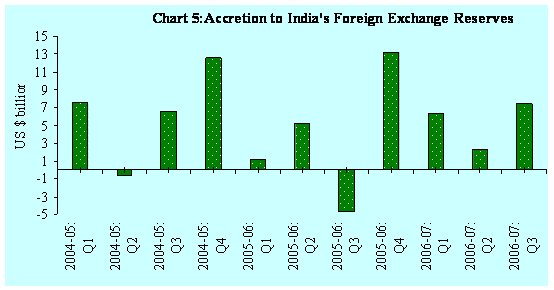
- At the end of December 2006, with outstanding foreign exchange reserves at
US $ 177.3 billion, India held the fifth largest stock of reserves among the emerging
market and sixth largest in the world.
Revisions
in BoP Data for first two quarters of 2006-07
According to the Revisions
Policy announced on September 30, 2004, the data for the first two quarters of
2006-07 are to be revised. The BoP data have been accordingly revised based on
latest information reported by various reporting entities. The revised data are
presented in the standard format of presentation in Statement
1, Statement
2. Alpana Killawala
Chief General Manager Press Release
: 2006-2007/1324 |





























